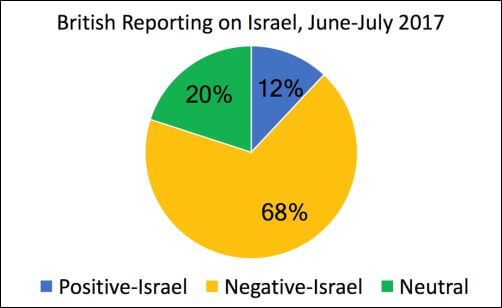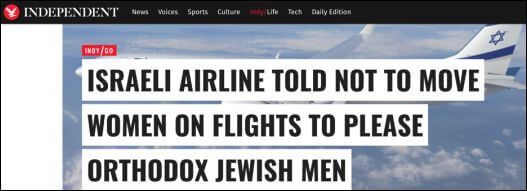HonestReporting’s Bias By the Numbers series crunches the numbers behind the media coverage of Israel, assessing and comparing some of the major news services. Isaac Hart breaks down the statistics and offers analysis based on our Red Lines series on the Eight Categories of Media Bias.
Bias By The Numbers’ previous edition revealed notable discrepancies between the British and American media markets. In raw terms, British outlets – led by The Independent – surveyed by HonestReporting in April and May published far more articles depicting Israel in a negative light than their American counterparts.
In reexamining these trends with new data collected over June and July, HonestReporting found that this pattern not only remained, but even worse, the total number of headlines critical of Israel in both American and British publications increased at similar rates. (Bias By The Numbers uses the terms “anti-Israel” and “negative” interchangeably for clarity.)
In every single publication examined, there was an increase in negative headlines towards Israel.
Join the fight for Israel’s fair coverage in the news
This was because of July’s Temple Mount-related unrest in Jerusalem which significantly boosted the amount of reporting from Israel in all the publications HonestReporting examined.
A reasonable increase in negative articles on Israel would naturally be expected to occur in a period like this. However, the negative reporting in two out of three publications (The Independent and Telegraph) surveyed in the British media market swelled to amounts out of proportion to previous figures. Conversely, negative reporting in The Guardian did increase only to a threshold within the April-May period’s distribution of anti-Israel articles in comparison to all Israel-related pieces published.
It bears mentioning why headlines matter: For an increasing number of people, what they know about the Mideast and many other topics comes from skimming headlines on their social media feeds. And for the few articles that do get clicked on, studies show that headlines impact the way people read and remember stories.
UK Media Market

The Independent rocketed past its April-May count of “only” 22 negative Israel stories to a massive new total of 37. Did all of these negative headlines include reasonable criticism of Israel? A short glance at violations of the Red Lines in The Independent indicates otherwise.
A distortion of facts, this Independent header muddles the truth of an attack by a Jordanian at the Israeli embassy in Amman.
Instead of identifying the attacker as a Jordanian man armed with a screwdriver, The Independent draws a false moral equivalency between the death of a terrorist and the guard he injured. The false framing of this attack distorts the truth to Western audiences, disillusioning readers’ views on Israel without a legitimate reason.
The Independent employed a lack of context with this headline to hide the truth from its readers. While Israel indeed did reduce the amount of power supplied to the Gaza Strip, it did so at the request of the Palestinian Authority, which has been steadily tightening the financial screws on Hamas over the course of the year.
This headline is an astonishing in its selective omission: Israel’s national airline was not merely “told” to stop switching seats on flights, abandoning a procedure allowing Orthodox Jews to avoid immodest contact with individuals of their opposite sex. El Al was given a court order to comply with the doctrine of gender equality before the law. This was not a feeble bureaucratic decree but a forcibly-applying legal directive.
In comparison to its Israel-related reporting in the April-May 2017 period, The Guardian maintained roughly the same proportion of negative articles to total articles.
However, the publication’s status quo was by no means superior to its competitors; an absurd 68% (proximate to the April-May level) of total articles published by The Guardian in June and July were anti-Israel and plenty fell prey to violations of HonestReporting’s Red Lines defining media bias.
This Guardian headline obfuscates the background of UNESCO’s decision to name Hebron’s Old City a World Heritage Site registered to the “State of Palestine.”
Controlled by regional Arab powers and their allies, UNESCO is a place for undemocratic states to exert their will against Israel – in this case, by lying about the historical record showing Hebron to be a site of immense and continuous Jewish history. When The Guardian doesn’t share this information with its audience in headlines, this is a textbook example of lack of context in journalism.
This Guardian headline is another well-crafted exhibition of lack of context. An average reader could reasonably (and falsely) assume that the aggressor in this story was an Israeli guard stationed at the Jordanian embassy. For comparison, the Times of Israel published this more complete headline, “Israeli stabbed at embassy in Jordan, attacker and second man shot dead.”
The Telegraph, a generally more conservative British publication, committed the same error as its competitors, The Independent and Guardian, when reporting on the shooting at the Israeli embassy in Amman.
American Media Market

American headlines, in both raw numbers and percentage, included significantly fewer anti-Israel motifs than British competitors in the June-July period. Still, over half Israel-related headlines run by the surveyed American media market were negative towards Israel. Like their UK counterparts, individually biased headlines were also prominent in the US papers.
This New York Times headline muddied the waters of a pair of near-simultaneous Palestinian terror attacks in Jerusalem. In one attack, Israeli Border Police officer Hadas Malka was stabbed to death. According to the Times, the Israeli “dies” in the passive voice, while the active verb is neither killed nor murdered but staged.
Meanwhile the Washington Post increased fourfold in June and July the number of headlines depicting the Jewish state in a positive light compared to the previous two-month period. Furthermore, the Post published more neutral articles on Israel than any other American publication.
Without speculating on the reasons for this, the Post’s recent positive strides in its coverage of Israel are notable and commendable and bear further watching.
This Washington Post headline, for example, correctly absolves Israel of the blame for internal Palestinian conflict over electricity supplied to Gaza. Unlike The Independent headline noted above – Israel cuts power supply to Gaza Strip as Palestinian Authority pressures Hamas – this article recognized Israel’s bystander-role in Mahmoud Abbas’ power struggle with Hamas. (The Independent headline was published one month earlier, but in reaction to the same issue.)
The Wall Street Journal is often described as a relatively balanced paper by pro-Israel media analysts; it certainly lived up to this reputation over the June-July period. It was the only paper surveyed by HonestReporting to have a plurality of neutral headlines on topics related to Israel and the Israeli-Arab conflict.
As with the Washington Post, a single two-month period is too brief to indicate any long-term policies in the Journal’s Israel reportage. Check back in October for further analysis on shifts in Israel-related reporting that incorporates new trends from the August and September period of study.
* * *
The Temple Mount crisis undoubtedly increased the drama in the Western media coverage. The intensity of this conflict may have been the cause of deviances from the American newsroom norm on Israel. As the Washington Post and Wall St. Journal demonstrated greater neutrality, European publications maintained their pattern of negative headlines.










